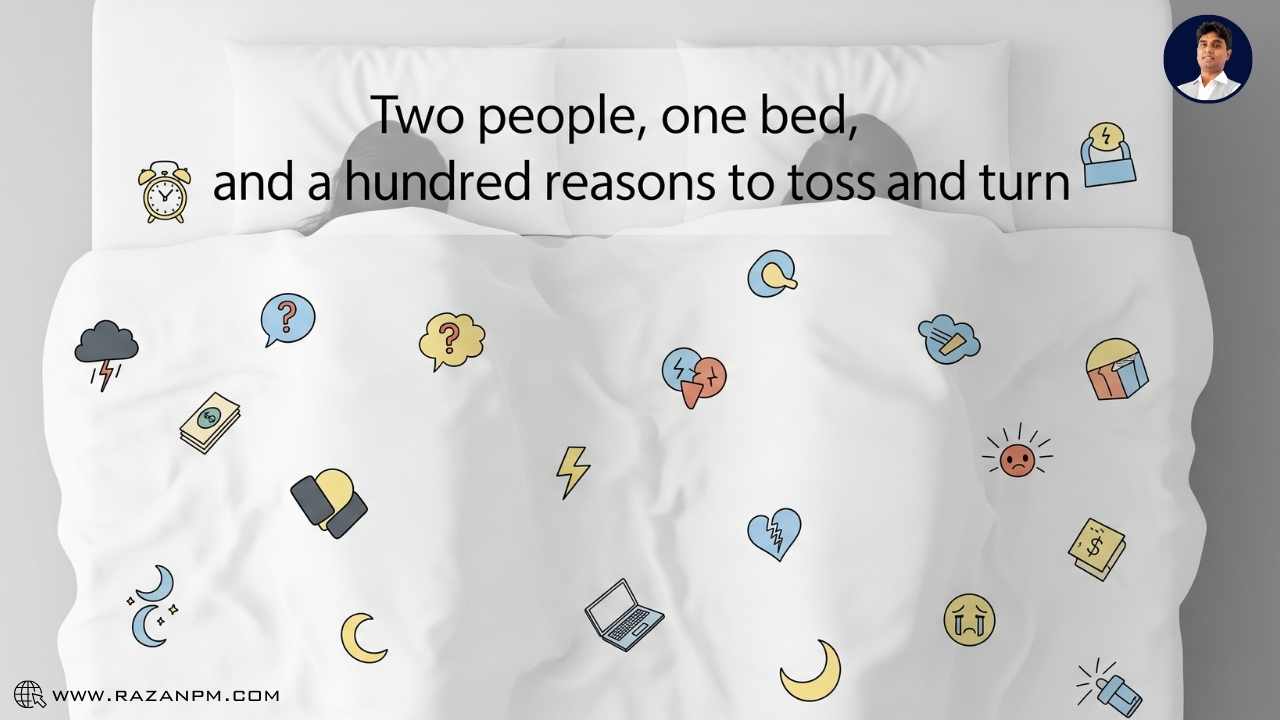The tiny sock on the lamp, the 2 a.m. crumb, and how small things can spin into late-night dread.
I always joke in clinic that relationships today can look like a sitcom: one missing fork becomes “we never communicate,” a forgotten text becomes “they don’t love me,” and a snore becomes a forensic investigation. The laugh is thin—because for many people a tiny nocturnal annoyance quickly tumbles into worry, shame, and sleepless nights. For Gen Z, one answer popping up on TikTok and in tiny apartments is: sleep apart. Is that a breakup signal—or a new care strategy? Let’s dig in like a therapist who also knows a few clever mind-and-language tricks.

Two people, one bed, and a hundred reasons to toss and turn. For some couples, sharing a bed means lost sleep, new fights, and a slow fray of tenderness. For younger adults, choosing separate bedrooms (sometimes called “sleep divorce”) is showing up as a surprisingly common choice—part practicality, part boundary-setting, part panic-avoidance. But when a practical choice triggers alarm (“Are they leaving me?”), the sleep solution becomes a relationship stressor.

People tell me: relief when they sleep better, guilt when they imagine partner’s loneliness, and a tiny buzzing fear that separate rooms equal emotional distance. Some feel liberated, others wounded. Many don’t know how to explain their choice without sounding cold, so they hide it, which breeds secrecy—the exact thing that fuels worry.

If these become chronic, daily mood and the relationship quality decline.

There’s no “separate-bed” diagnosis, but living patterns like this often intersect with recognized conditions. Persistent excessive worry about relationships can look like Generalized Anxiety Disorder (DSM-5 code 300.02 / ICD-10 F41.1) or heighten symptoms of panic or sleep disorders (ICD - 10 G47.* for sleep problems). Attachment-related patterns - anxious or avoidant orientations - shape how people interpret bedroom choices: anxious types may read separation as abandonment; avoidant types may prefer it as a comfort strategy. These attachment patterns are well-studied and influence both sleep and relationship quality.
A body of research shows sleep and relationship quality influence each other - poor sleep predicts more conflict and lower relationship satisfaction, and relationship stress harms sleep. Reviews and studies find the link is bi-directional. Surveys and sleep medicine groups report a growing number of people choosing separate sleeping arrangements to protect sleep health - over a third of adults in some surveys say they sometimes or regularly sleep apart. Importantly, separate sleeping does not automatically mean an unhappy relationship if couples keep intentional emotional connection outside bedtime.
A couple I worked with, Priya and Aarav (names changed), arrived because small nightly things were exploding into daily fights. Aarav’s snoring and Priya’s restless legs meant neither slept. Priya secretly started using the guest room; guilt ate her. In therapy we tried an experiment: Priya slept separately for two weeks and they agreed on three morning rituals - coffee, a ten-minute walk, and a “one-sentence gratitude” before noon. Priya slept. Aarav felt less invaded. The fights faded. The secret guilt transformed into a shared plan and a new kind of tenderness. That’s when I realized: the solution is not only about bedrooms - it’s about meaning, language, and tiny rituals that rebuild safety.
Below are practical, evidence-informed methods I use as a clinician combined with compact language-and-sensory techniques (explained simply so anyone can use them).

1) Make it a mutual experiment, not a verdict
Say aloud: “Let’s trial two weeks of separate sleeping to see if we both feel better.” Framing it as an experiment reduces catastrophic thinking and gives a time-limited safety net.
2) Re-story the meaning
When one partner fears abandonment, guide them to rewrite the internal story. Replace “They left me” with “We tried a different way to protect sleep - let’s see how connection looks now.” Use simple aloud phrases at bedtime and morning to create a new shared narrative.
3) Anchor a safety cue
Pick a short, physical or verbal cue that signals connection (a 2-second hand squeeze, a single word like “I’m here,” or a shared scent on a pillow). Whenever worry spikes, use the cue to stop runaway thoughts and reconnect bodily.
4) Sensory rehearsal before sleep
Five minutes before bed, each partner practices a calming five-step routine: slow breathing, soft light, a tactile comfort (blanket or pillow), a brief calming phrase out loud, and a safety cue. Repetition trains the nervous system to associate bedtime with calm, not alarm.
5) Micro-commitments for intimacy
Create tiny, consistent touchpoints—one morning coffee, one midday text that’s not logistical, one weekly “bedroom date” where you sleep together intentionally. These micro-commitments keep intimacy alive without forcing nightly co-sleep.
6) Language reset for arguments
When a worry surfaces, use a short script: “I noticed I’m feeling [name the feeling]. Can we take five minutes to say what we need?” Naming feelings reduces escalation and models emotional safety.
7) Track sleep + mood together
Keep a simple joint chart of sleep hours and mood. Data reduces emotional guessing and shows if separate sleeping is helping.
Partner A: “I feel worried when we sleep apart.”
Partner B: “Thank you for saying that. My plan helped my sleep. Can we try the morning walk together every day this week so you know I’m still here?”
These steps are brief, practiceable, and rooted in attachment research and sleep studies. They turn a physical boundary into a shared practice of care.
👉 Begin Your Journey with a 1 on 1 Consultation
👉 Begin Your Journey with a 1 on 1 Consultation
